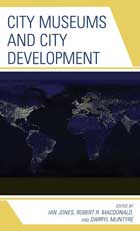
Several of the authors in this volume of papers make reference to the fact that in 2007, for the first time, over half of the world's human population was living in cities. In that year a conference was held in Vienna sponsored by the rather clumsily named International Committee for the Collections and Activities of Museums of Cities (CAMOC), an international committee of ICOM founded in 2005. The book is based on papers presented at the Vienna meeting.
Books that arise from conferences are often uneven and poorly structured but City Museums and City Development is an exception. Ian Jones sets the scene by stating that the theme is the contribution that a museum about a city can make to its development. Long-established city museums may be primarily repositories of city treasures, in imposing nineteenth-century buildings and often established by historical societies, but a newer breed is concerned with having an impact on the planning of cities by acting as a source of knowledge to influence development. George Prevelakis argues that cities are entering the arena of iconographic competition to counter the homogenising effects of globalisation and, for that reason, museums about cities are moving from a marginal position to a central one. Several writers stress the role of city museums in planning, although I could find no specific example cited of an occasion when the presence of the museum made the crucial difference in determining the shape of the city. The sense of place that a city museum provides is another common theme, but a number of contributors express anxiety about the challenge of reflecting the sheer scale and diversity of a city in a single museum. Caroline Butler-Bowden and Susan Hunt discuss the Museum of Sydney and make this telling observation: the museum 'has long debated what the title of a city museum really means and whether, given its small physical size, it can be a city museum or rather an interesting museum in the city'. Sydney is one of the case-studies, together with Stuttgart, Taipei and Kazan, a place I had never previously heard of but which is the capital of Tatarstan and one of Russia's largest cities.
Max Hebditch, former director of the Museum of London, provides a useful corrective to the preconception that most of the urban population live in big cities. As he points out, in the south-west region of England where he now resides, most people live in small towns or villages despite England being one of the most densely populated countries in the world. Small rural towns are under particular pressure from centralisation and economic changes, such as the growth of large out-of-town shopping complexes. Their museums face challenges that vary in the particular circumstances of the town. He examines a county town, a faded seaside resort, and a tourist town on the coast. The current director of the Museum of London, Jack Lohman, describes the constantly changing nature of cities and particularly the people who live in them, with the necessity to reflect that in collections and exhibitions. The new galleries in the Museum of London opened in May 2010. It will be interesting to see how his concepts of how urban museums should contribute to civic life are realised in the new exhibitions.
The final chapter is based on the results of a survey of city museums that examines the framework in which they operate, their mission, social involvement, strengths and weaknesses, trends and best practice. Of 150 museums invited to participate, only 35 responded, but the results are none-the-less interesting and are presented in detail.
Not all museums that have cities as at least part of their subject matter self-identify as city museums. Melbourne Museum has a name that sounds as if it is a city museum; and it includes a large exhibition, the Melbourne Story, that provides a rich array of objects, narratives and personal stories which offer many insights into the city. It does so, however, in the context of a large, encyclopedic museum. In Manchester, the world's first industrial city, the Museum of Science and Industry (which I directed from 1983 until 2002) presented galleries such as The Making of Manchester and Underground Manchester as an integral part of a large museum in which the city was woven into its fabric. The Manchester Art Gallery has the Manchester Gallery that presents the city's past and present. The museum and the art gallery therefore provide the city with complementary insights into its character and history, but in the context of more wide-ranging subject matter than a strictly city museum would attempt. Interestingly, another Manchester organisation, Urbis, was billed as the 'Museum of the Modern City' when it opened in 2002, and was committed to examining modern cities and looking to their future. After a troubled existence it is now being converted into the National Football Museum. There are, therefore, two topics that a future meeting of CAMOC, and subsequent book, might examine. The strengths and weaknesses of city museums compared with cities as part of general museums is one. The other is the challenge of looking to the future in city museums. It is identified as an integral part of the role of a city museum by several of the contributors to City Museums and City Development. However, in my experience the future that is foretold by museums is often that of the local authority's planning department rather than an insightful, extensive examination that would make a real contribution to public debate.
